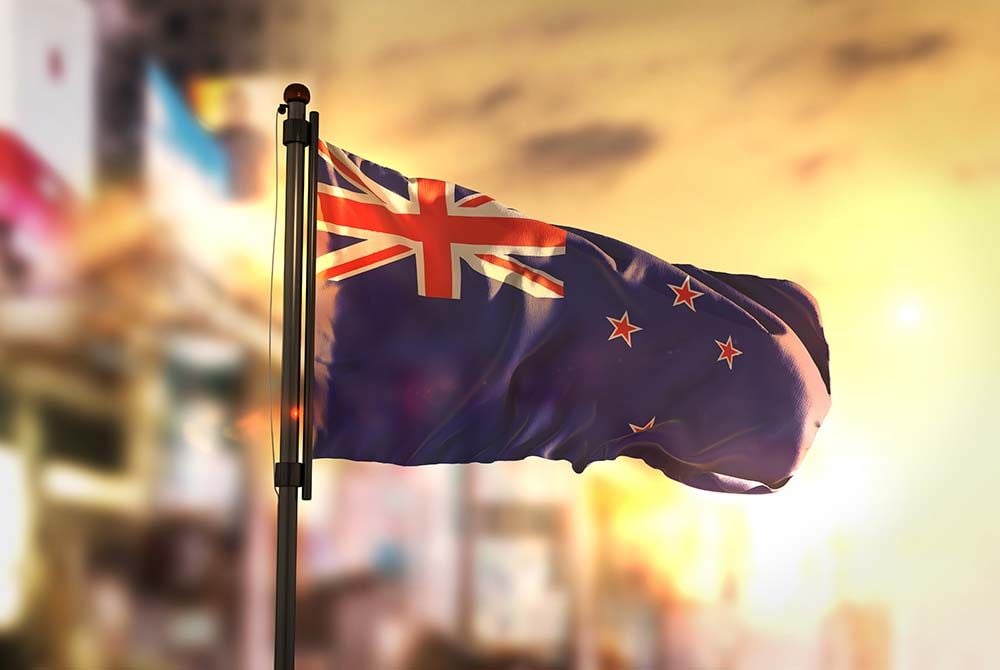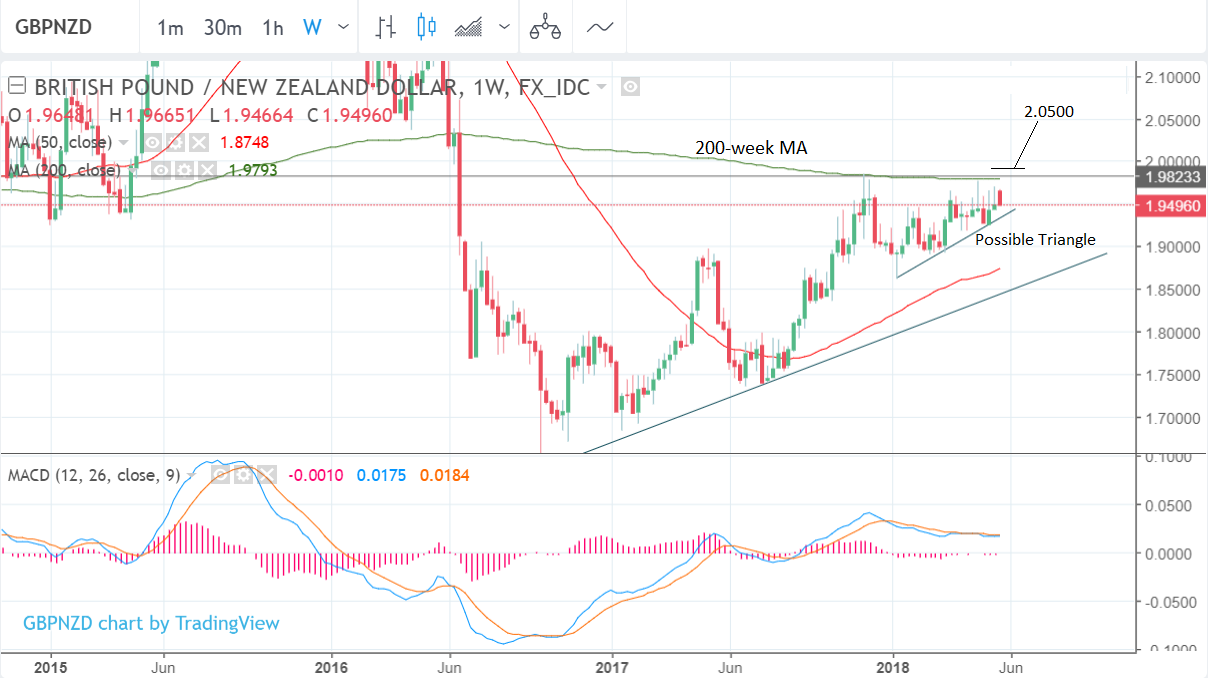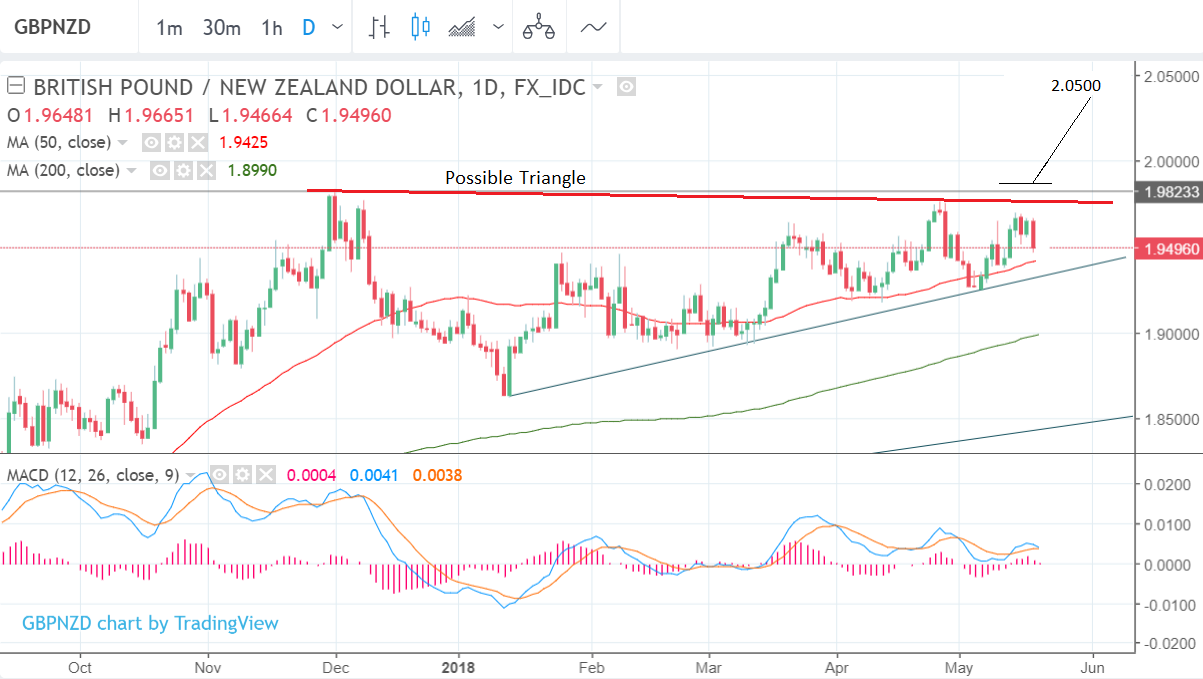The Pound-to-New Zealand Dollar Rate's Forecast For The Week Ahead
- GBP/NZD may have formed a bullish pattern which could lead to a rally above 2.0000
- The main release for the Pound in the week ahead is retail sales data
- For the New Zealand Dollar the two main releases are retail sales and the trade balance

© Natanael Ginting, Adobe Stock
One Pound buys 1.9496 New Zealand Dollars on the eve of the new week on the interbank market.
GBP/NZD has been rising ever since the 2017 lows and now appears to have formed what looks very much like a possible triangle pattern.
The 200-week moving average is blocking the road higher but could still give way.
From previously adopting a non-committal stance we now think the pair is showing marginally bullish potential.
Right-angled triangles differ from normal triangles by having one edge which is flat, which in this case it is the upper edge. The importance of the flat side is that it also provides a clue as to the direction in which the triangle is most likely to break - which in this case is higher.
A continuation of the uptrend would be conditional on a rise above the current range highs in the 1.98s and a clearance of 2.00.
The final upside target for a breakout would be 2.05, calculated by extrapolating the height of the triangle pattern at its widest part higher from the top by the golden ratio (0.618).
NZD: What to Watch
The main release in the week ahead for the New Zealand Dollar (Kiwi) is Q1 retail sales, which is out this evening (Sunday) at 23.45 GMT.
"Q1 real retail sales are expected to surge by 2.0%, driven by the 2.3% increase in retail card sales for the quarter, and assuming a modest deflator," says TD Securities.
"April sales were weak, hinting at a brief pause in spending. The RBNZ is monitoring wages and inflation so little macro implications even if this print surprises to the upside," adds TD.
At the Reserve Bank of New Zealand's (RBNZ's) recent interest rate meeting, RBNZ governor Orr said they would not be contemplating putting up interest rates for quite some time, and the Kiwi lost a lot of ground as a result.
Even if retail sales come out substantially better-than-expected it will almost certainly not be enough to radically change the outlook for interest rates, and these are the main driver of the Kiwi. Higher interest rates tend to appreciate the currency as they attract greater inflows of foreign capital drawn by the promise of higher returns.
The other major release for the Kiwi is the trade balance released at 23.45 on Wednesday, May 23, which previously showed a deficit of -86m. It is not a failsafe correlation, but the greater the surplus the better it usually is for a currency as it is indicative of greater demand for the country's exports; and vice versa for a deficit.
GBP: What to Watch
It's a busy week ahead for Sterling traders, with a welter of economic releases due to the Pound.
Inflation data, out at 9.30 on Wednesday, forms the main data event with traders looking to see whether prices are moving in a direction consistent with further interest rate rises at the Bank of England (BOE). Over recent months we have seen the Pound become increasingly attuned to BOE interest rate expectations; moving higher when expectations for a rate rise increase, and moving lower when those expectations are rowed back.
We recently reported that economists at Capital Economics are expecting two interest rate rises in 2018 which would present a highly bullish outcome for Sterling, but the data will have to start moving in the right direction very soon for this assumption to prove correct.
And of course, the Bank of England is watching the data and will only move on rates once they have evidence the economy is picking up the pace once more.
"UK inflation figures from April will be closely watched by markets and influence the pricing of Bank of England," says Andreas Steno Larsen, a strategist at Nordea Bank.
Inflation is expected to fall to 2.1% from 2.3% as base effects from the weak Pound start to fall away.
"As for April there is a clear risk of a rather low result due to base effects," adds Larsen.
Analysts at Investec are more bullish about inflation in April:
"We expect to see inflation tick up to 2.6% from 2.5%, albeit with the April rise likely to be a blip on a path in which we see inflation moderating," says Investec economist Victoria Clarke.
Global oil prices have been on the rise, and we would expect this to perhaps deliver an upside surprise. However, the core CPI release will, therefore, be crucial as it strips out the likes of external one-offs like oil, and the Bank of England uses the number as a proxy for underlying wage growth. In short, a beat on the core CPI would likely help Sterling higher, the core is forecast to read at 0.5%.
In other UK releases, retail sales figures due Thursday morning will also be closely watched amidst concerns about UK growth (and consumer spending) momentum.
The BRC’s April figures were particularly weak, with the timing of Easter a depressing factor; we suspect the ONS’s Easter timing adjusted numbers will not look quite so gloomy.
The second estimate for UK GDP growth is due at the end of the week where Clarke suspects we will see an unrevised reading of +0.1% print. A beat would however likely boost Sterling.
Right at the beginning of the week, we get some second-tier numbers with public sector finances released at 9.30, they are expected to show government borrowing fall by 7.0bn in April. Recent public sector data has been positive on the whole so a further fall in borrowing would be seen as a positive for the economy, although a surprise reading, either way, would probably be necessary to move the Pound.
The Consortium of British Industry will also be releasing two reports for the month of May: the CBI Industrial Trends survey at 11.00 GMT on Monday and the Distributive Trades survey at the same time on Wednesday. Both will provide the most up-to-date information on economic activity in the UK and could, because of their timeliness, impact on Sterling.
Get up to 5% more foreign exchange by using a specialist provider to get closer to the real market rate and avoid the gaping spreads charged by your bank when providing currency. Learn more here.











